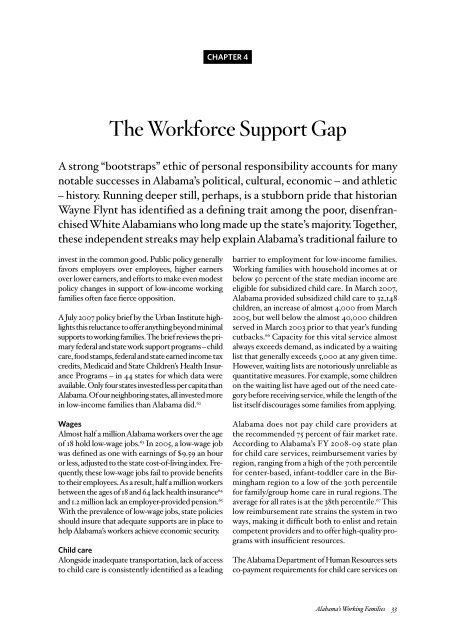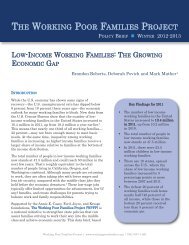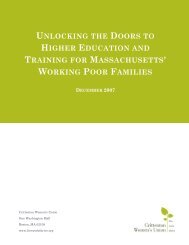alabama's working families and the broken promise of economic ...
alabama's working families and the broken promise of economic ...
alabama's working families and the broken promise of economic ...
- No tags were found...
Create successful ePaper yourself
Turn your PDF publications into a flip-book with our unique Google optimized e-Paper software.
CHAPTER 4The Workforce Support GapA strong “bootstraps” ethic <strong>of</strong> personal responsibility accounts for manynotable successes in Alabama’s political, cultural, <strong>economic</strong> – <strong>and</strong> athletic– history. Running deeper still, perhaps, is a stubborn pride that historianWayne Flynt has identified as a defining trait among <strong>the</strong> poor, disenfranchisedWhite Alabamians who long made up <strong>the</strong> state’s majority. Toge<strong>the</strong>r,<strong>the</strong>se independent streaks may help explain Alabama’s traditional failure toinvest in <strong>the</strong> common good. Public policy generallyfavors employers over employees, higher earnersover lower earners, <strong>and</strong> efforts to make even modestpolicy changes in support <strong>of</strong> low-income <strong>working</strong><strong>families</strong> <strong>of</strong>ten face fierce opposition.A July 2007 policy brief by <strong>the</strong> Urban Institute highlightsthis reluctance to <strong>of</strong>fer anything beyond minimalsupports to <strong>working</strong> <strong>families</strong>. The brief reviews <strong>the</strong> primaryfederal <strong>and</strong> state work support programs – childcare, food stamps, federal <strong>and</strong> state earned income taxcredits, Medicaid <strong>and</strong> State Children’s Health InsurancePrograms – in 44 states for which data wereavailable. Only four states invested less per capita thanAlabama. Of our neighboring states, all invested morein low-income <strong>families</strong> than Alabama did. 62WagesAlmost half a million Alabama workers over <strong>the</strong> age<strong>of</strong> 18 hold low-wage jobs. 63 In 2005, a low-wage jobwas defined as one with earnings <strong>of</strong> $9.59 an houror less, adjusted to <strong>the</strong> state cost-<strong>of</strong>-living index. Frequently,<strong>the</strong>se low-wage jobs fail to provide benefitsto <strong>the</strong>ir employees. As a result, half a million workersbetween <strong>the</strong> ages <strong>of</strong> 18 <strong>and</strong> 64 lack health insurance 64<strong>and</strong> 1.2 million lack an employer-provided pension. 65With <strong>the</strong> prevalence <strong>of</strong> low-wage jobs, state policiesshould insure that adequate supports are in place tohelp Alabama’s workers achieve <strong>economic</strong> security.Child careAlongside inadequate transportation, lack <strong>of</strong> accessto child care is consistently identified as a leadingbarrier to employment for low-income <strong>families</strong>.Working <strong>families</strong> with household incomes at orbelow 50 percent <strong>of</strong> <strong>the</strong> state median income areeligible for subsidized child care. In March 2007,Alabama provided subsidized child care to 32,148children, an increase <strong>of</strong> almost 4,000 from March2005, but well below <strong>the</strong> almost 40,000 childrenserved in March 2003 prior to that year’s fundingcutbacks. 66 Capacity for this vital service almostalways exceeds dem<strong>and</strong>, as indicated by a waitinglist that generally exceeds 5,000 at any given time.However, waiting lists are notoriously unreliable asquantitative measures. For example, some childrenon <strong>the</strong> waiting list have aged out <strong>of</strong> <strong>the</strong> need categorybefore receiving service, while <strong>the</strong> length <strong>of</strong> <strong>the</strong>list itself discourages some <strong>families</strong> from applying.Alabama does not pay child care providers at<strong>the</strong> recommended 75 percent <strong>of</strong> fair market rate.According to Alabama’s FY 2008-09 state planfor child care services, reimbursement varies byregion, ranging from a high <strong>of</strong> <strong>the</strong> 70th percentilefor center-based, infant-toddler care in <strong>the</strong> Birminghamregion to a low <strong>of</strong> <strong>the</strong> 30th percentilefor family/group home care in rural regions. Theaverage for all rates is at <strong>the</strong> 38th percentile. 67 Thislow reimbursement rate strains <strong>the</strong> system in twoways, making it difficult both to enlist <strong>and</strong> retaincompetent providers <strong>and</strong> to <strong>of</strong>fer high-quality programswith insufficient resources.The Alabama Department <strong>of</strong> Human Resources setsco-payment requirements for child care services onAlabama’s Working Families 33







